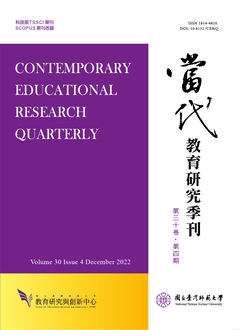

學習優弱勢族群的辨識是重要的學術課題,也是教育政策決策與支持體系規劃的主要依據,更需要實徵資料提供證據支持。本研究利用臺灣教育長期追蹤資料庫(Taiwan Education Panel Survey,TEPS)的貫時性資料,以潛在成長模式與混合成長模式估計學生學習成就軌跡,藉以辨識優弱勢異質族群,並探討相關影響因素。TEPS資料庫中2,806 位學生的學習成就四波調查的潛在成長模式分析結果發現,臺灣中學階段學生的學習成就成長軌跡呈現非線性的遞增漸緩的成長曲線。混合成長模式分析則得到三個異質族群:正常成長族群呈現能力遞增的成長曲線,兩個相對弱勢的族群則呈現起點低落或成長有限的變動曲線。進一步分析發現,教育分流與區位因素是區辨異質族群的主要原因,而負向文化資本亦有顯著的預測力,由不同族群者的起點與成長型態呈現扇形擴展,顯示潛在分群下的異質群體軌跡差異呈現馬太效應(Matthew effects)。本研究除了對於異質族群的內涵意義與相關影響因素進行分析與解釋之外,並對本文的方法學意義與研究限制進行討論。
Identifying superior and inferior groups of academic achievements is notonly the major concern of academic researchers but also the foundation ofpolicy-making and supplementary system design, all relying on the support ofempirical evidences. In this study, data of 2,806 students selected from theTaiwan Education Panel Survey (TEPS) in four consecutive time periods areadapted to identify the latent clusters of superiority and inferiority in thestudents’ achievement. The heterogeneity of the achievement trajectories isidentified by the growth mixture modeling. The results show that the nonlinearmodel has the best fit for the observed data. An analysis of the mixturemodeling indicates three heterogeneous classes on the trajectories, of whichthe typical-growth class has a gradually improved achievement curve. On theother hand, the two relatively inferior groups have a lower starting level or adecreased trend at the later waves of achievement measures. Furthermore, theinferior classes are identified by the differential schooling sectors and thelocation conditions with high level of negative culture capital. In contrast, thetypical-growth class is improving relatively smoothly in the different learningstages in both the public and the normal schools. The fan-shaped pattern oftrajectories supports the phenomenon of the Matthew effects. In addition toillustrating the heterogeneous trajectory and its influential factors, this studydiscusses the implications and limitations of several methodological issues.

本著作係採用創用 CC 姓名標示-非商業性 3.0 台灣 授權條款授權.
本刊國立台灣師範大學教育研究與創新中心
106台北市和平東路一段162號 | 電話: 02-7749-3670 | E-mail: cerecerq@gmail.com
教創中心 | 師大 | 電子報 | 線上投審系統
本刊由國家科學及技術委員會人文社會科學研究中心補助經費
© 2014 CERI-NTNU
